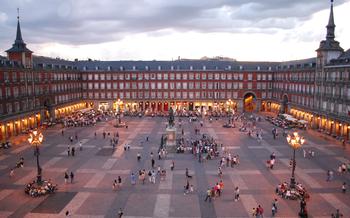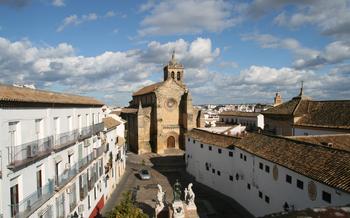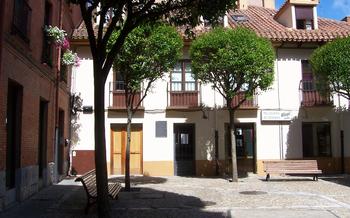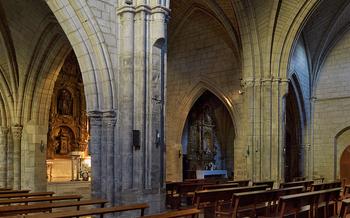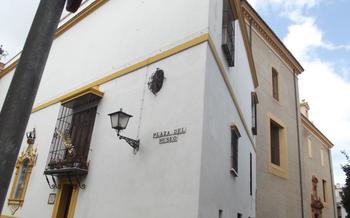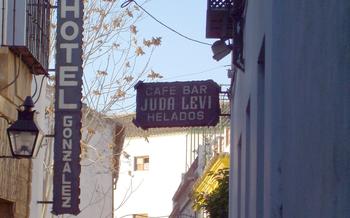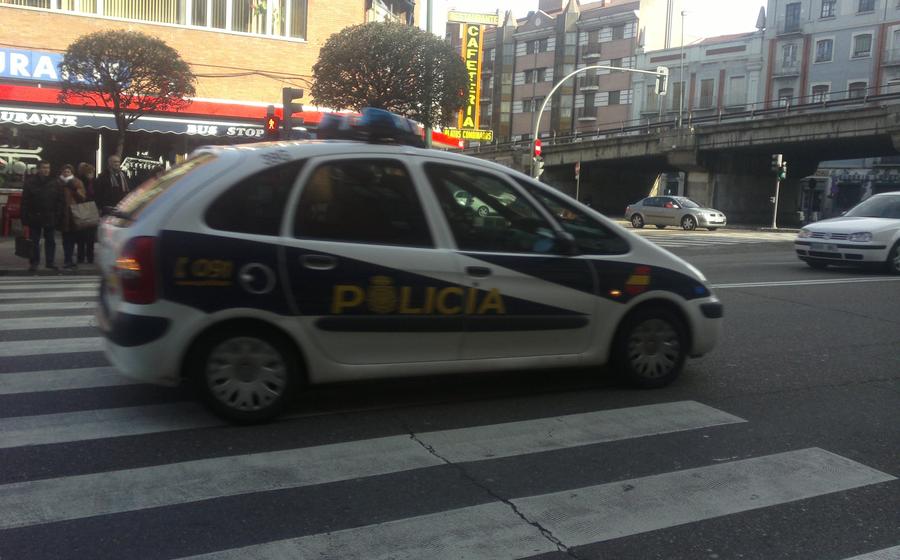
Ruta de Isabel la Católica (nearby attraction)
- Palencia: City of Art and History
- Medina de Rioseco: A Town of Mudejar Architecture
- Tordesillas: A Royal Town with a Dark Past
- Simancas: A Town of Archives
- Peñafiel: A Town with a Castle and a Wine Region
- Cuéllar: A Town of Mudéjar Architecture
- Coca: A Town with a Castle
- Íscar: A Town with a Romanesque Church
- Laguna de Duero: A Town with a Renaissance Palace
- Zaratán: A Town with a Bullfighting Tradition
- Valladolid: A City with a Rich History and Vibrant Culture
- Tips for Visiting the Ruta de Isabel la Católica
- Suggested Itineraries for Visiting the Ruta de Isabel la Católica
- Insider Tip
Palencia: City of Art and History
Palencia, a city steeped in history and renowned for its architectural wonders, beckons travelers to embark on a journey through time. Founded by the Romans, Palencia proudly stands as a testament to the enduring legacy of ancient civilizations. The city's rich heritage is intricately woven into its urban fabric, inviting visitors to explore the captivating tales of its past.
At the heart of Palencia lies the awe-inspiring Cathedral, a masterpiece of Gothic architecture that transports visitors to a realm of ethereal beauty. Its intricate carvings, soaring spires, and stained-glass windows narrate the city's spiritual journey throughout the centuries. Every nook and cranny of the Cathedral conceals hidden treasures, whispering secrets of faith, devotion, and artistic brilliance.
For those seeking a deeper immersion into Palencia's cultural heritage, the Museo de Palencia beckons with its captivating collection of archaeological and artistic wonders. Here, visitors can embark on a journey through time, tracing the city's evolution from its humble beginnings to its present-day glory. Ancient artifacts, exquisite paintings, and fascinating sculptures narrate the story of a city that has witnessed the ebb and flow of history.
As day transitions into twilight, Palencia's historic center transforms into a vibrant tapestry of sights, sounds, and flavors. The city's lively plazas buzz with the laughter of locals and the enticing aromas of traditional cuisine. Whether savoring the delectable flavors of Castilian gastronomy or simply soaking in the convivial atmosphere, visitors can truly immerse themselves in the essence of Palencia.
Medina de Rioseco: A Town of Mudejar Architecture
Medina de Rioseco is a town located in the province of Valladolid, in the autonomous community of Castile and León, Spain. It is a town of great historical and cultural importance, and is known for its Mudejar architecture, a style that combines Islamic and Christian elements.
One of the most important examples of Mudejar architecture in Medina de Rioseco is the Iglesia de Santa María de Mediavilla, a 16th-century church with a stunning Mudejar tower. The church is a UNESCO World Heritage Site, and is one of the most important examples of Mudejar architecture in Spain.
Another important example of Mudejar architecture in Medina de Rioseco is the Plaza Mayor, a beautiful square surrounded by historic buildings. The square is home to the Ayuntamiento (town hall) and the Teatro Municipal (municipal theater), both of which are fine examples of Mudejar architecture.
In addition to its Mudejar architecture, Medina de Rioseco is also home to a number of other historical and cultural attractions. The town has a long history dating back to the Middle Ages, and was once a major trading center. Medina de Rioseco is also home to a number of museums, including the Museo de Medina de Rioseco, which houses a collection of artifacts and documents from the town's history.
Tordesillas: A Royal Town with a Dark Past
Tordesillas, a captivating town nestled in the heart of Castile and León, boasts a rich and intricate tapestry of history. As the former residence of the Catholic Monarchs, Isabel and Ferdinand, Tordesillas exudes an aura of royalty and grandeur. The Royal Palace of Tordesillas, a magnificent Renaissance masterpiece, stands as a testament to the town's illustrious past. With its opulent gardens and exquisite architecture, the palace transports visitors to a bygone era of regal splendor.
In the annals of history, Tordesillas is indelibly linked to the tragic tale of Queen Juana la Loca, daughter of Isabel and Ferdinand. Following the death of her husband, Philip the Handsome, Juana descended into a profound state of grief and madness. Confined within the walls of the Monasterio de Santa Clara, she spent the final years of her life in seclusion, haunted by the memories of love and loss. Visitors can delve into this poignant chapter of history as they explore the monastery, where Juana's presence still lingers in the shadows.
Tordesillas is also home to the Museo Sefardí, a poignant tribute to the town's once-thriving Jewish community. Through a collection of artifacts, documents, and interactive exhibits, the museum sheds light on the vibrant culture and traditions of the Sephardic Jews who called Tordesillas home. Visitors can trace the community's rich history, from its humble beginnings to its eventual expulsion from Spain in 149
As you wander through the cobblestone streets of Tordesillas, the town's rich heritage unfolds before your eyes. Majestic churches, quaint plazas, and historic buildings tell the story of a town that has witnessed centuries of change and upheaval. Whether you're a history buff, an architecture enthusiast, or simply a curious traveler, Tordesillas offers an immersive experience that will transport you to a time when royalty, tragedy, and resilience intertwined to shape the destiny of this remarkable town.
Simancas: A Town of Archives
Nestled in the heart of the Castilla y León region, Simancas is a town steeped in history and renowned for its exceptional archives. As the former home to the Royal Archives of Spain, Simancas holds a treasure trove of historical documents that shed light on the nation's rich past.
At the heart of the town lies the Archivo General de Simancas, a UNESCO World Heritage Site that houses an awe-inspiring collection of over 30 million documents. These invaluable records span centuries, offering insights into the reigns of Spanish monarchs, the exploration of the Americas, and the intricate workings of the Spanish Empire.
Beyond its archival treasures, Simancas boasts a charming historic center that invites exploration. The town's narrow streets are lined with traditional architecture, showcasing the harmonious blend of Gothic, Renaissance, and Mudejar influences.
As you wander through Simancas, take a moment to admire the Iglesia de Santa María, a magnificent Gothic-Renaissance church that dominates the town's skyline. Its intricate facade and soaring bell tower are a testament to the town's rich artistic heritage.
For a deeper dive into Simancas' past, visit the Museo de Simancas, which houses a diverse collection of artifacts and documents that erzählen die Geschichte of the town's evolution. From prehistoric settlements to the present day, the museum offers a comprehensive glimpse into Simancas' fascinating journey through time.
Whether you're a history buff, an architecture enthusiast, or simply seeking a tranquil escape, Simancas promises an enriching and memorable experience. Its wealth of historical treasures, combined with its picturesque charm, make it a must-visit destination along the Ruta de Isabel la Católica.
Peñafiel: A Town with a Castle and a Wine Region
Peñafiel is a charming town located in the province of Valladolid, in the Castile and León region of Spain. The town is known for its impressive castle, the Castillo de Peñafiel, which dominates the town from its hilltop location. The castle was built in the 10th century and is one of the best-preserved castles in Spain. Visitors can explore the castle's interior, which includes a museum that tells the story of the castle's history.
Peñafiel is also known for its winemaking tradition. The town is located in the heart of the Ribera del Duero wine region, which is one of the most prestigious wine regions in Spain. Visitors can visit the Museo del Vino, which tells the story of the town's winemaking tradition. They can also visit the surrounding vineyards and wineries, where they can sample the region's delicious wines.
In addition to its castle and wine region, Peñafiel is also home to a number of other attractions, including the Plaza Mayor, a beautiful square surrounded by historic buildings; the Iglesia de Santa María, a 13th-century church with a stunning Gothic altarpiece; and the Museo de Arte Contemporáneo, which houses a collection of contemporary art.
Peñafiel is a great place to visit for those who are interested in history, wine, and culture. The town's stunning castle, delicious wines, and rich history make it a must-visit destination for anyone traveling to the Ruta de Isabel la Católica.
Cuéllar: A Town of Mudéjar Architecture
Cuéllar is a town in the province of Segovia, Castile and León, Spain. It is located on the banks of the Cega River, about 50 km northeast of Segovia city. The town has a rich history dating back to the Middle Ages, and is home to a number of well-preserved Mudéjar buildings.
The most notable Mudéjar building in Cuéllar is the Iglesia de San Miguel, a 13th-century church with a beautiful Mudejar tower. The tower is decorated with intricate brickwork and ceramic tiles, and is one of the most iconic landmarks in the town.
Another important Mudéjar building in Cuéllar is the Palacio de los Duques de Alburquerque, a 15th-century palace that is now home to the town hall. The palace has a beautiful Mudéjar façade, with a pointed arch doorway and windows decorated with brickwork and ceramic tiles.
In addition to its Mudéjar architecture, Cuéllar is also home to a number of other historical buildings, including the Castillo de Cuéllar, a 15th-century castle that is now a museum; the Convento de San Francisco, a 16th-century convent that is now home to a hotel; and the Plaza Mayor, a beautiful square surrounded by historic buildings.
Cuéllar is a charming town with a rich history and culture. It is a great place to visit for anyone interested in Mudéjar architecture or Spanish history.
Coca: A Town with a Castle
Coca is a charming town in the province of Segovia, Castilla y León, Spain. Situated on the banks of the Eresma River, Coca is known for its impressive Castillo de Coca, a 15th-century castle that is one of the best examples of Mudejar architecture in Spain. The castle, which is surrounded by a moat, features a mixture of Islamic and Gothic elements, including horseshoe arches, geometric patterns, and crenellated towers.
Coca's historic center is a delight to explore, with its narrow streets, traditional houses, and historic churches. The Iglesia de Santa María la Mayor is a 12th-century Romanesque church that features a beautiful apse with blind arcades and a rose window. The Iglesia de San Nicolás is another notable church, which dates back to the 13th century and features a Gothic portal and a Mudejar tower.
Coca is also known for its winemaking tradition and is home to several wineries. The Museo de la Vid y el Vino tells the story of the town's winemaking history and offers visitors the chance to sample the region's delicious wines.
Coca is a peaceful town with a stunning setting, making it a great place to relax and enjoy the surrounding countryside. The town is surrounded by vineyards, rolling hills, and forests, and offers a variety of outdoor activities, such as hiking, biking, and fishing.
Íscar: A Town with a Romanesque Church
Íscar is a charming town located in the province of Valladolid, in the Castile and León region of Spain. The town is known for its stunning Romanesque architecture, particularly the Iglesia de Santa María la Mayor. This 12th-century church is one of the most important Romanesque churches in Spain and is a must-see for any visitor to the town. The church features a beautiful Romanesque façade with intricate carvings and a stunning interior with a barrel-vaulted ceiling and a series of chapels.
In addition to the Iglesia de Santa María la Mayor, Íscar is home to a number of other historic buildings, including the Plaza Mayor, the Town Hall, and the Museo de Íscar. The Plaza Mayor is a beautiful square surrounded by historic buildings, while the Town Hall is a 16th-century building that houses the town's government offices. The Museo de Íscar tells the story of the town's history and culture and is a great place to learn more about Íscar and its people.
Íscar is a small town with a population of just over 6,000 people. However, despite its small size, the town has a lot to offer visitors. Íscar is a great place to experience the region's rich history and culture, and it is also a great base for exploring the surrounding countryside.
Laguna de Duero: A Town with a Renaissance Palace
Discover the charming town of Laguna de Duero, located just a short distance from Valladolid. The town is home to the impressive Palacio de los Condes de Miranda, a 16th-century Renaissance palace that is considered one of the most important Renaissance palaces in Spain. The palace is a testament to the town's rich history and cultural heritage.
Explore the town's historic center, with its narrow streets and traditional houses. Admire the beautiful architecture and soak up the town's peaceful atmosphere. Visit the Museo de Laguna de Duero, which tells the story of the town's history and culture. Learn about the town's traditions and customs, and discover the stories of the people who have lived here over the centuries.
Enjoy the town's stunning views of the surrounding countryside. Take a stroll through the town's parks and gardens, and relax in the peaceful atmosphere. Laguna de Duero is a perfect place to escape the hustle and bustle of city life and enjoy the tranquility of the Spanish countryside.
Zaratán: A Town with a Bullfighting Tradition
Zaratán is a town with a long and rich bullfighting tradition. The town's bullring, the Plaza de Toros de Zaratán, is one of the most important bullrings in Spain and has hosted some of the country's most famous bullfighters.
Visitors to Zaratán can immerse themselves in the world of bullfighting by visiting the bullring and attending a bullfight. The bullring is a beautiful example of Spanish architecture and is a great place to learn about the history and culture of bullfighting.
In addition to the bullring, Zaratán is also home to the Museo Taurino de Zaratán, a museum dedicated to the history of bullfighting in the town. The museum houses a collection of artifacts from the town's bullfighting past, including posters, photographs, and bullfighting suits.
Zaratán is a great place to visit for anyone who is interested in learning more about bullfighting. The town's bullring and museum offer a unique opportunity to experience the history and culture of this traditional Spanish sport.
Valladolid: A City with a Rich History and Vibrant Culture
Discover the rich history of Valladolid, a city that was once the capital of Spain and played a crucial role in the country's development. Wander through the city's historic center, where narrow streets and traditional houses create a charming and evocative atmosphere. Explore the Museo Nacional de Escultura, which houses a remarkable collection of sculptures from the Middle Ages to the present day. Immerse yourself in the city's vibrant cultural scene, with its many theaters, museums, and art galleries. Experience the city's lively nightlife, with its bars, restaurants, and clubs that cater to every taste. Valladolid is a city that seamlessly blends its rich historical heritage with a modern and vibrant lifestyle.
Tips for Visiting the Ruta de Isabel la Católica
Planning your trip in advance is crucial, as some towns and villages along the route are small and may lack tourist infrastructure. Ensure you wear comfortable shoes, as you will be doing a lot of walking. Bring a camera to capture the stunning scenery and historical landmarks. Learning a few basic Spanish phrases can be helpful, as not everyone in the region speaks English.
Suggested Itineraries for Visiting the Ruta de Isabel la Católica
If you have a week, you can visit all of the towns and villages along the route. Start in Palencia, and then visit Becerril de Campos, Medina de Rioseco, Tordesillas, Simancas, Peñafiel the region and its history.
If you have less time, you can focus on the most important towns and villages. Start in Palencia, and then visit Medina de Rioseco, Tordesillas, Simancas, and Valladolid. This route will allow you to see the most important historical and cultural sites in the region.
You can also choose to visit the route by car or by bicycle. If you are traveling by car, you will have more flexibility and can stop at more places along the way. If you are traveling by bicycle, you will be able to experience the region at a slower pace and get a closer look at the scenery.
No matter how you choose to travel, the Ruta de Isabel la Católica is a journey that you will never forget.
Insider Tip
If you are visiting the Ruta de Isabel la Católica in the summer, be sure to bring a hat and sunscreen, as the weather can be very hot. The summer months in Spain can be scorching, with temperatures often reaching into the 40s Celsius (104 degrees Fahrenheit). The sun can be particularly intense during the midday hours, so it is important to protect yourself from the heat. Be sure to drink plenty of water and take breaks in the shade to avoid dehydration and heatstroke. It is also a good idea to wear light, loose-fitting clothing made from natural fibers, such as cotton or linen.

